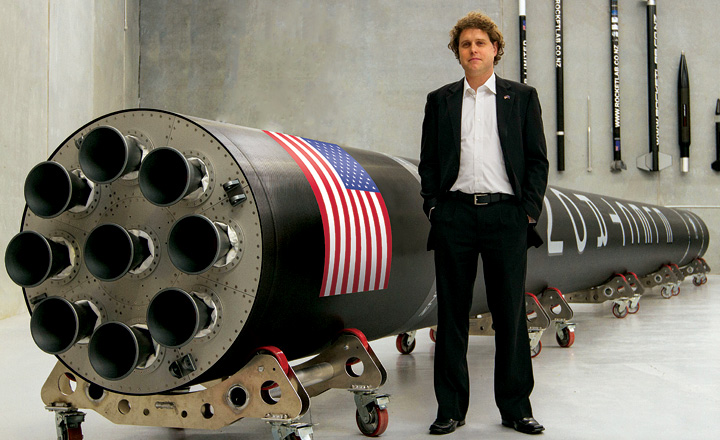Growing up in a family of engineers, Peter Beck’s fascination with space started when he was a kid. He would accompany his dad who was the museum director at the Southland Museum for meetings where they discussed space and telescopes, most of it went over his head but he was hooked. So much so, he even built his own telescope. Rather than going academic and opting for a university degree, Beck preferred to learn engineering by getting his hands dirty first in his family’s garage by building go-karts and tinkering around with cars. He moved to Dunedin in 1995 for an apprenticeship at Fisher & Paykel where he built a rocket bike that went from zero to 140 kmph in less than five seconds.
For Beck, it was always about rockets. He spent almost a decade working on space tech, including his stint at a government research firm. In 2006, it was during a trip to the US where he visited NASA and Lockheed Martin, he realised that his childhood dream of working with one of them wasn’t going to be the way he imagined. He would have to jump through too many hoops to do what he wants, which is to build and launch rockets.
So, on the flight back to New Zealand he decided on the name and logo of the company he was going to start. Six months later he quit his job and started Rocket Lab. “Our mission is to make space accessible to a larger population and remove all the barriers to commercial space. These are exciting times for the space industry and all the growth is happening in small satellites. So, there is a definite need for a dedicated service to launch small satellites at an affordable cost which traditional rocket systems don’t offer,” says Peter Beck, founder and CEO, Rocket Lab. Traditionally, most small satellites would share the ride on rockets carrying much larger payloads. So, they would have no real control over when or where the launches will take place and may have to choose orbits that may not be best suited for their research initiatives since they are piggybacking on rockets carrying larger payloads.

The cheapest option available for companies today is Elon Musk’s SpaceX’s Falcon 9 rocket, which is larger and more powerful, and costs about $60 million, while the average launch of rockets in the US costs around $132 million. Rocket Lab is offering a single flight at about $5 million to its customers. What’s more, the prohibitive costs and time taken to build a rocket meant there weren’t enough launches happening every year. Even in the US, which is the largest spender on space, there were about 19 launches in the past year. Beck believes the barriers will be truly removed not only if the costs are lower, but also if there is a substantial increase in the launch frequency. “Our aim is to have one launch every week. We will initially start with one launch a month and even that is something, given that the US had only 19 launches in 2015,” says Beck. The plan is to go bi-monthly by the next couple of years and, eventually, make it a weekly affair.
When you set audacious goals like Rocket Lab did for itself, you don’t make incremental changes to existing technology — you start with a fresh piece of paper. That’s what they did when they started to build their engine, Rutherford, named after Nobel Prize-winning physicist Ernst Rutherford. The team was not allowed to use any processes or parts that were previously being used when they started to work on it. They were building a rocket engine from scratch. “We did push the boundaries of innovation and we weren’t afraid to use the latest technologies. A lot of the innovative technologies we developed, such as 3D printing of engine parts, carbon composite structures and proprietary battery technology, have helped us to meet our goal of keeping costs low and improving the launch frequency,” says Beck. Rutherford adopts an entirely new propulsion cycle using an electric motor to drive its turbopumps, which propel fuel into the combustion chamber at the requisite flow and pressure. Using 3D printing not only reduces the costs but also dramatically lowers the time it takes to build the engine. While it takes months to build an engine, Rocket Lab can build the Rutherford in three days.
The Electron rocket can carry payloads of up to 150 kg to the 500 km sun-synchronous orbits. The satellites in the sun-synchronous orbits would fly over one point on the earth at the same time everyday. The first stage of the Electron rocket uses nine engines to get the rocket off the earth. The second stage uses one engine to provide improved performance in the vacuum conditions of the space and eventually deliver the payload into the orbit. The use of advanced carbon composites gives Electron a strong and lightweight flight structure and its liquid oxygen compatible composite tanks provide significant weight savings. This gives Electron an overall mass efficiency, that is one of the best in this category of space rockets. “Apart from some machining components which is done outside, the entire design and almost all the manufacturing is done in-house,” reveals Beck. Having full control over production and design gives Rocket Lab the ability to mass produce rockets, because if the aim is to eventually have one launch every week, then the company should also be able to manufacture one rocket a week.
To have the highest frequency in launches and have a better control over the schedule of launches, Rocket Lab has set up its own orbital launch in Mahia Peninusla in New Zealand. The company chose Mahia, given its remote location and low marine and air traffic, which is ideal for launches. The company now has a licence to launch every 72 hours. The facilities at the site include a vehicle-processing hangar where the vehicle will be prepared for launch as well as a 50-tonne launch platform, which will tilt the rocket to a vertical position before launch. “We looked at other countries for the launch site but New Zealand proved to be ideal in the end. Sometimes, I wish we were building only rockets, but it is essential to have the whole infrastructure such as the launch site and monitoring stations in place, and that’s what we have done,” says Beck. It was not easy, though, since Rocket had to go through several regulatory approvals, and bilateral treaties had to be signed. “But having our own launch site will play a crucial role in achieving our goals,” says Beck. He also says that by using the launch facilities at places such as Cape Canaveral, makes every launch costlier by $1 million.
Rocket Lab raised an undisclosed amount in its Series B round in March 2015 with Bessemer Venture Partners leading the round along with Khosla Ventures and New Zealand-based K1W1, which had invested in an earlier round in 2013.
 The company currently has contracts with NASA as well as startups in the small satellite space, including Planet Labs, Spire, and Moon Express. Small satellites are being used for earth imaging, disaster prediction, monitoring climate change, weather tracking, intelligence gathering, and communication networks. While it has three contracts with Planet Labs, and one with NASA, there are multiple contracts with Moon Express which is trying to win the Google Lunar XPrize, which offers a $30 million prize for the first private spacecraft to land on the moon, and about a dozen contracts with Spire which is looking to launch 70-plus satellites over the next one year. “Rocket Lab is providing a service that just doesn’t exist today. Companies like Spire, which are launching small satellites using purely rideshare opportunities, will be able to depend on a more regular launch schedule, or book their own dedicated rides at a much lower cost than what we pay today,” says Jenny Barna, launch manager at Spire. While the rideshare option largely addresses the challenge of getting to space for small satellites, the costs are still significant. Rocket Lab’s real advantage is the offering of a dedicated (small) launch; for the first time ever in the $5 million range, the 100-150 kg satellite owner can choose where and when it launches and have the luxury of being treated with the technical and programmatic attention of a primary payload. “If we use the airplane analogy, Rocket Lab would be providing the first opportunity to charter your own small jet,” says Barna.
The company currently has contracts with NASA as well as startups in the small satellite space, including Planet Labs, Spire, and Moon Express. Small satellites are being used for earth imaging, disaster prediction, monitoring climate change, weather tracking, intelligence gathering, and communication networks. While it has three contracts with Planet Labs, and one with NASA, there are multiple contracts with Moon Express which is trying to win the Google Lunar XPrize, which offers a $30 million prize for the first private spacecraft to land on the moon, and about a dozen contracts with Spire which is looking to launch 70-plus satellites over the next one year. “Rocket Lab is providing a service that just doesn’t exist today. Companies like Spire, which are launching small satellites using purely rideshare opportunities, will be able to depend on a more regular launch schedule, or book their own dedicated rides at a much lower cost than what we pay today,” says Jenny Barna, launch manager at Spire. While the rideshare option largely addresses the challenge of getting to space for small satellites, the costs are still significant. Rocket Lab’s real advantage is the offering of a dedicated (small) launch; for the first time ever in the $5 million range, the 100-150 kg satellite owner can choose where and when it launches and have the luxury of being treated with the technical and programmatic attention of a primary payload. “If we use the airplane analogy, Rocket Lab would be providing the first opportunity to charter your own small jet,” says Barna.
With over 30 contracts, the company’s flight manifest is fully booked until the end of 2018 and that is a good problem for the company whose 120-member team is now focused on getting to the launch. The company has completed several milestones that put it on track to begin its test phase flight including the qualification testing of its Rutherford engine. The second stage of Electron has been cleared for flight along with the infrastructure of the launch site, testing facilities and remote monitoring stations now in place. The company is now working on the qualification tests to clear the first stage of Electron to begin its test flight phase which the company hopes to complete by the year end.
Despite the rigour that goes into testing the engine, rocket, and the facilities, you can never really rule out accidents during launches which could act as temporary setbacks for both Rocket Lab and its customers. But that is something that comes with the territory and the company says that it is doing its best to build the most reliable launch vehicle. There have been 200 test fires on the Rutherford engine thus far and Beck believes that the more launches they have, the more reliable they become. He is hopeful that Rocket Lab’s three-flight test program will help them iron out the chinks in their armour before they start flying. The engineering that goes into building the rocket is not an easy task coupled with the regulatory processes and the development of infrastructure. “Getting to space is a hard thing to do. But what we are building is transformational. We are excited that we are enabling the small satellite revolution and are working very hard to get to the launch date soon,” mentions Beck. That intent is best captured on the company’s website, which reads: “Space is now open for business.”











